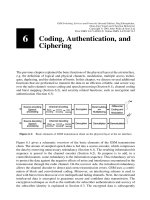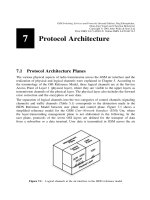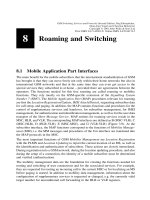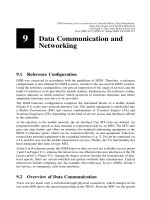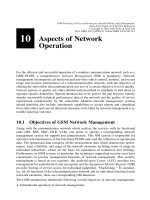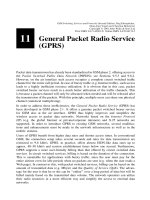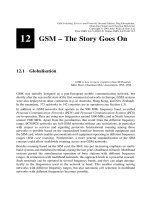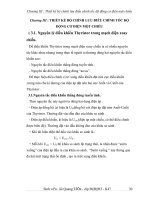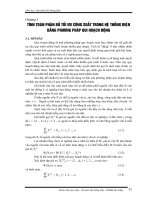Tài liệu GSM Switching, Services and Protocols P3 docx
Bạn đang xem bản rút gọn của tài liệu. Xem và tải ngay bản đầy đủ của tài liệu tại đây (386.02 KB, 17 trang )
System Architecture and
Addressing
3.1 General Description
GSM networks are structured hierarchically (Figure 3.1). They substantially consist of at
least one administrative region,which is assigned to a Mobile Switching Center (MSC).
Each administrative region is made up of at least one Location Area (LA). Sometimes the
LA is also called the visited area. An LA consists of several cell groups. Each cell group is
assigned to a Base Station Controller (BSC). Therefore for each LA there exists at least
one BSC,but cells of one BSC may belong to different LAs.
The exact partitioning of the service area into cells and their organization or administration
with regard to LAs,BSCs,and MSCs is,however,not uniquely determined and is left to
the respective network operator who thus has many possibilities for optimization. Figure
3.2 shows the system architecture of a GSM Public Land Mobile Network (PLMN) with
essential components. The hierarchical construction of the GSM infrastructure becomes
evident again. The cell is formed by the radio area coverage of a Base Transceiver Station
(BTS). Several base stations together are controlled by one BSC. The combined traf®c of
the mobile stations in their respective cells is routed through a switch,the Mobile Switch-
ing Center (MSC). Calls originating from or terminating in the ®xed network (e.g. the
Integrated Services Digital Network,ISDN [7]) are handled by a dedicated Gateway
3
Figure 3.1: GSM system hierarchy
GSM Switching, Services and Protocols: Second Edition. Jo
È
rg Eberspa
È
cher,
Hans-Jo
È
rg Vo
È
gel and Christian Bettstetter
Copyright q 2001 John Wiley & Sons Ltd
Print ISBN 0-471-49903-X Online ISBN 0-470-84174-5
Mobile Switching Center (GMSC). Operation and maintenance are organized from a
central place,the Operation and Maintenance Center (OMC). Several databases are avail-
able for call control and network management:
² Home Location Register (HLR)
² Visited Location Register (VLR)
² Authentication Center (AUC)
² Equipment IdentityRegister (EIR)
For all subscribers registered with a network operator,permanent data (such as the user's
service pro®le) as well as temporary data (such as the user's current location) are stored in
the HLR. In case of a call to a user,the HLR is always ®rst queried,to determine the user's
current location. A VLR is responsible for a group of LAs and stores the data of subscribers
who are currently in its area of responsibility. This includes parts of the permanent
subscriber data which have been transmitted from the HLR to the VLR for faster access.
But the VLR may also assign and store local data such as a temporary identi®cation. The
AUC generates and stores security-related data such as keys used for authentication and
encryption,whereas the EIR registers equipment data rather than subscriber data.
3.2 Addresses and Identi®ers
GSM distinguishes explicitly between user and equipment and deals with them separately.
According to this concept,which was introduced with digital mobile networks,mobile
equipment and users each receive their own internationally unique identi®ers. The user
3 System Architecture and Addressing
30
Figure 3.2: GSM system architecture with essential components
identity is associated with a mobile station by means of a personal chip card,the Subscri-
ber IdentityModule (SIM). This SIM usually comes in the form of a chip card,which is
transferable between mobile stations. It allows to distinguish between equipment mobility
and subscriber mobility. The subscriber can register to the locally available network with
his or her SIM card on different mobile stations,or the SIM card could be used as a normal
telephone card in the ®xed telephone network. However,he or she cannot receive calls on
®xed network ports,but further development of the ®xed networks as well as convergence
of ®xed and mobile networks could make this possible,too. In that case,a mobile subscri-
ber could register at an arbitrary ISDN telephone and would be able to receive calls.
In addition,GSM distinguishes between subscriber identity and telephone number. This
leaves some scope for development of future services when each subscriber may be called
personally,independent of reachability or type of connection (mobile or ®xed). Besides the
personal identi®er,each GSM subscriber is assigned one or several ISDN numbers.
Besides telephone numbers and subscriber and equipment identi®ers,several other identi-
®ers have been de®ned; they are needed for the management of subscriber mobility and for
addressing all the remaining network elements. The most important addresses and identi-
®ers are presented in the following.
3.2.1 International Mobile Station Equipment Identity (IMEI)
The International Mobile Station Equipment Identity (IMEI) uniquely identi®es mobile
stations internationally. It is a kind of serial number. The IMEI is allocated by the equip-
ment manufacturer and registered by the network operator,who stores it in the Equipment
IdentityRegister (EIR). By means of the IMEI one recognizes obsolete,stolen,or nonfunc-
tional equipment and,for example,can deny service. For this purpose,the IMEI is
assigned to one or more of three categories within the EIR:
² The White List is a register of all equipment.
² The Black List contains all suspended equipment. This list is periodically exchanged
among network operators.
² Optionally,an operator may maintain a Gray List,in which malfunctioning equipment
or equipment with obsolete software versions is registered. Such equipment has
network access,but its use is reported to the operating personnel.
The IMEI is usually requested from the network at registration,but it can be requested
repeatedly. It is a hierarchical address,containing of the following parts:
² Type Approval Code (TAC): 6 decimal places,centrally assigned
² Final AssemblyCode (FAC): 6 decimal places,assigned by the manufacturer
² Serial Number (SNR): 6 decimal places,assigned by the manufacturer
² Spare (SP): 1 decimal place
Thus,IMEI TAC 1 FAC 1 SNR 1 SP. It uniquely characterizes a mobile station and
gives clues about the manufacturer and the date of manufacturing.
3.2 Addresses and Identi®ers
31
3.2.2 International Mobile Subscriber Identity (IMSI)
When registering for service with a mobile network operator,each subscriber receives a
unique identi®er,the International Mobile Subscriber Identity (IMSI). This IMSI is stored
in the SIM; see Section 3.3.1. A mobile station can only be operated if a SIM with a valid
IMSI is inserted into equipment with a valid IMEI,since this is the only way to correctly
bill the associated subscriber. The IMSI also consists of several parts:
² Mobile CountryCode (MCC): 3 decimal places,internationally standardized
² Mobile Network Code (MNC): 2 decimal places,for unique identi®cation of mobile
networks within a country
² Mobile Subscriber Identi®cation Number (MSIN): maximum 10 decimal places,iden-
ti®cation number of the subscriber in his/her mobile home network
The IMSI is a GSM-speci®c addressing concept and is different from the ISDN numbering
plan. A 3-digit MCC has been assigned to each of the GSM countries,and 2-digit MNCs
have been assigned within countries (e.g. 262 as MCC for Germany; and MNC 01,02,03,
and 07 for the networks known as D1-Telekom,D2-Privat,E-Plus,and E2-Interkom,
respectively). Subscriber identi®cation therefore uses a maximum of 15 decimal digits,
and IMSI MCC 1 MNC 1 MSIN. Whereas the MCC is de®ned internationally,the
National Mobile Subscriber Identity (NMSI MNC 1 MSIN) is assigned by the operator
of the home PLMN.
3.2.3 Mobile Subscriber ISDN Number (MSISDN)
The ``real telephone number'' of a mobile station is the Mobile Subscriber ISDN Number
(MSISDN). It is assigned to the subscriber (his or her SIM),such that a mobile station can
have several MSISDNs depending on the SIM. With this concept,GSM is the ®rst mobile
system to distinguish between subscriber identity and number to call. The separation of
call number (MSISDN) and subscriber identity (IMSI) primarily serves to protect the
con®dentiality of the IMSI. In contrast to the MSISDN,the IMSI need not be made public.
With this separation,one cannot derive the subscriber identity from the MSISDN,unless
the association of IMSI and MSISDN as stored in the HLR has been made public. It is the
rule that the IMSI used for subscriber identi®cation is not known,and thus the faking of a
false identity is signi®cantly more dif®cult.
In addition to this,a subscriber can hold several MSISDNs for selection of different
services. Each MSISDN of a subscriber is reserved for speci®c service (voice,data,fax,
etc.). In order to realize this service,service-speci®c resources have to be activated in the
mobile station as well as in the network. The service desired and the resources needed for
the speci®c call can be derived from the MSISDN. Thus,an automatic activation of
service-speci®c resources is already possible during the setup of a connection. The
MSISDN categories follow the international ISDN numbering plan and therefore have
the following structure:
² CountryCode (CC): up to 3 decimal places
² National Destination Code (NDC): typically 2±3 decimal places
² Subscriber Number (SN): maximal 10 decimal places
3 System Architecture and Addressing
32
The CCs are internationally standardized,complying to the ITU-T E.164 series [32]. There
are country codes with one,two,or three digits; e.g. the country code for the USA is 1,for
the UK it is 44,and for Finland it is 358. The national operator or regulatory administration
assigns the NDC as well as the subscriber number SN,which may have variable length.
The NDC of the mobile networks in Germany have three digits (170,171,172,¼). The
subscriber number is the concatenation MSISDN CC 1 NDC 1 SN and thus has a
maximum of 15 decimal digits. It is stored centrally in the HLR.
3.2.4 Mobile Station Roaming Number (MSRN)
The Mobile Station Roaming Number (MSRN) is a temporary location-dependent ISDN
number. It is assigned by the locally responsible VLR to each mobile station in its area.
Calls are routed to the MS by using the MSRN. On request,the MSRN is passed from the
HLR to the GMSC. The MSRN has the same structure as the MSISDN:
² CountryCode (CC) of the visited network
² National Destination Code (NDC) of the visited network
² Subscriber Number (SN) in the current mobile network
The components CC and NDC are determined by the visited network and depend on the
current location. The SN is assigned by the current VLR and is unique within the mobile
network. The assignment of an MSRN is done in such a way that the currently responsible
switching node MSC in the visited network (CC 1 NDC) can be determined from the
subscriber number,which allows routing decisions to be made.
The MSRN can be assigned in two ways by the VLR: either at each registration when the
MS enters a new Location Area (LA) or each time when the HLR requests it for setting up
a connection for incoming calls to the mobile station.
In the ®rst case,the MSRN is also passed on from the VLR to the HLR,where it is stored
for routing. In the case of an incoming call,the MSRN is ®rst requested from the HLR of
this mobile station. This way the currently responsible MSC can be determined,and the
call can be routed to this switching node. Additional localization information can be
obtained there from the responsible VLR.
In the second case,the MSRN cannot be stored in the HLR,since it is only assigned at the
time of call setup. Therefore the address of the current VLR must be stored in the tables of
the HLR. Once routing information is requested from the HLR,the HLR itself goes to the
current VLR and uses a unique subscriber identi®cation (IMSI and MSISDN) to request a
valid roaming number MSRN. This allows further routing of the call.
3.2.5 Location Area Identity (LAI)
Each LA of a PLMN has its own identi®er. The Location Area Identi®er (LAI) is also
structured hierarchically and internationally unique (Section 3.2.2),with LAI again
consisting of an internationally standardized part and an operator-dependent part:
² CountryCode (CC): 3 decimal digits
² Mobile Network Code (MNC): 2 decimal places
3.2 Addresses and Identi®ers
33
² Location Area Code (LAC): maximum 5 decimal places,or maximum twice 8 bits,
coded in hexadecimal (LAC , FFFF
hex
)
This LAI is broadcast regularly by the base station on the Broadcast Control Channel
(BCCH). Thus,each cell is identi®ed uniquely on the radio channel as belonging to an LA,
and each MS can determine its current location through the LAI. If the LAI that is ``heard''
by the MS changes,the MS notices this LA change and requests the updating of its location
information in the VLR and HLR (location update). The signi®cance for GSM networks is
that the mobile station itself rather than the network is responsible for monitoring the local
conditions of signal reception,to select the base station that can be received best,and to
register with the VLR of that LA which the current base station belongs to. The LAI is
requested from the VLR if the connection for an incoming call has been routed to the
current MSC using the MSRN. This determines the precise location of the mobile station
where the mobile can be subsequently paged. When the mobile station answers,the exact
cell and therefore also the base station become known; this information can then be used to
switch the call through.
3.2.6 Temporary Mobile Subscriber Identity (TMSI)
The VLR being responsible for the current location of a subscriber can assign a Temporary
Mobile Subscriber Identity (TMSI),which has only local signi®cance in the area handled
by the VLR. It is used in place of the IMSI for the de®nite identi®cation and addressing of
the mobile station. This way nobody can determine the identity of the subscriber by
listening to the radio channel,since this TMSI is only assigned during the mobile station's
presence in the area of one VLR,and can even be changed during this period (ID hopping).
The mobile station stores the TMSI on the SIM card. The TMSI is stored on the network
side only in the VLR and is not passed to the HLR. A TMSI may therefore be assigned in
an operator-speci®c way; it can consist of up to 4 £ 8 bits,but the value FFFF FFFF
hex
is
excluded,because the SIM marks empty ®elds internally with logical 1.
Together with the current location area,a TMSI allows a subscriber to be identi®ed
uniquely,i.e. for the ongoing communication the IMSI is replaced by the 2-tuple
(TMSI,LAI).
3.2.7 Local Mobile Subscriber Identity (LMSI)
The VLR can assign an additional searching key to each mobile station within its area to
accelerate database access; this is the Local Mobile Station Identity (LMSI). The LMSI is
assigned when the mobile station registers with the VLR and is also sent to the HLR. The
LMSI is not used any further by the HLR,but each time messages are sent to the VLR
concerning a mobile station,the LMSI is added,so the VLR can use the short searching
key for transactions concerning this MS. This kind of additional identi®cation is only used
when the MSRN is newly assigned with each call. In this case,fast processing is very
important to achieve short times for call setup. Like the TMSI,an LMSI is also assigned in
an operator-speci®c way,and it is only unique within the administrative area of a VLR. An
LMSI consists of four octets (4 £ 8 bits).
3 System Architecture and Addressing
34
